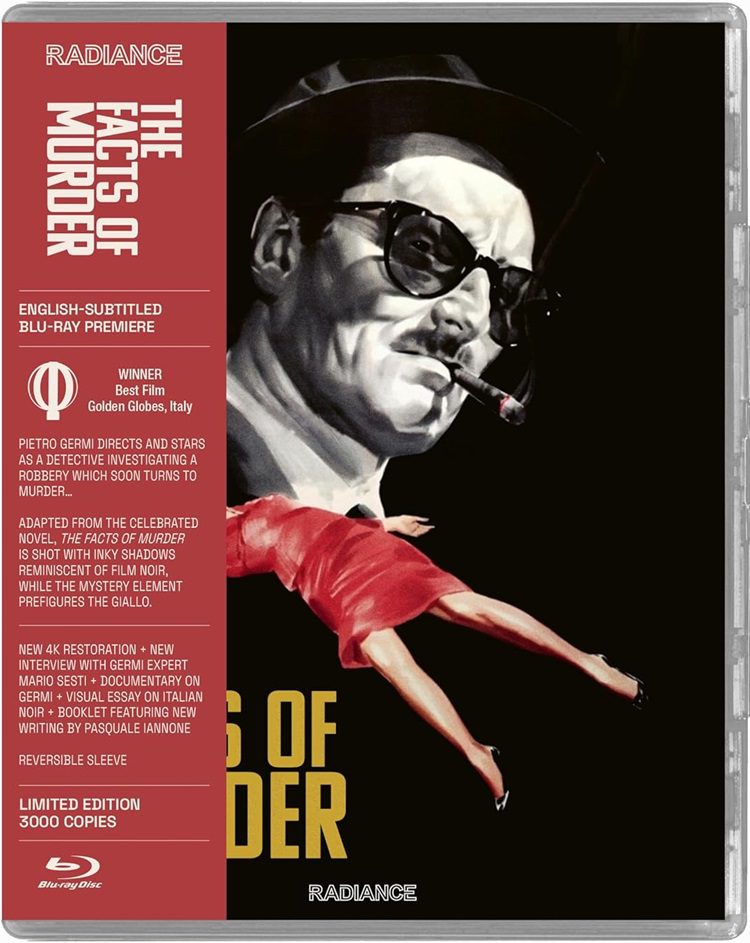
During the fascist regime of Mussolini, films and stories about crime were either deeply censored or outright banned in Italy. We can’t have your citizens thinking law-breaking is glamorous, can we? Once the war was over and Mussolini dead, the floodgates were open and Italy was awash with American films and stories. Film noir and hard-boiled detective fiction were all the rage. As is their wont, the Italians took these things and made them their own.
In the special features included on this new Blu-ray release of The Facts of Murder from Radiance Films critics Paul A. J. Lewis and Roberto Curti discuss how the American film noir begat Italian neorealism which in turn influenced the poliziotteschi and then the giallo. I’m a fan of those genres and the similarities between them are obvious, but I wasn’t aware just how deep they go until reading and watching these extras.
The Facts of the Murder is something of a blending between those genres (well, except for the giallo; it is a bit too austere for that). It is a bit similar to Jules Dassin’s 1948 film Night and the City; it has that same documentary sensibility though it is shot with some style and wit.
Pietro Germi directs and stars as Ciccio Ingravallo, a police investigator baffled by two seemingly unrelated crimes – a jewel robbery and a murder. Had they not taken place on consecutive days in the same apartment buildings, on the same floor even, he would never suspected they were connected, but that’s too big of a coincidence to ignore.
The thief seemed to know exactly where the jewels were inside Commendatore Anzaloni’s (Ildebrando Santafe) apartment so suspicions fall on those who might have knowledge and access. This includes Diomede (Nino Castelnuovo), the fiancee of Assuntina (Claudia Cardinale), the servant girl of Anzaloni’s neighbor Liliana Banducci (Eleonora Rossi Drago). This is especially true when he runs away when he sees the police talking to Assuntina. Ah, but he has an alibi.
It is another neighbor, Dr. Valdarena (Franco Fabrizi), who discovers Lilliana lying dead in her apartment, and calls the police. But not before slipping an envelope full of cash with his name on it into his pocket. It seems everyone is suspicious, and everyone has their secrets.
The clues come fast and furious. The film isn’t particularly interested in realistic investigative techniques or shoe leather. The police ask questions and look for clues, but more often than not information comes to them. Inspector Ingravallo is of the hard-boiled variety, always chomping cigars, wearing sunglasses indoors, and periodically slapping a suspect around when the mood strikes him. Germi plays him like a leaner, meaner Columbo (one could easily see this character in an NBC movie of the week on a regular basis). As a director, he keeps things moving swiftly, piling up clue after clue until the audience struggles to keep up.
It is shot beautifully, allowing the natural corners and shadows of the apartment complex to give it a noir feeling. Though events unfold too quickly to be realistic is it shot naturalistically allowing it to resemble classic neorealism. Ingravallo’s toughness slides him toward the rugged characters of the poliziotteschi, but not so much that you can truly place the film in that genre. So like I said, it is something of a blending of genres and styles. The end result isn’t perfect but it is really quite good.
Radiance Films has given The Facts of Murder a lovely 4K restoration from the original negative. Extras include an interview with Pietro Germi expert Mario Sesti, an archival documentary on Germi and his films, a visual essay on Italian film noir by Paul A. J. Lewis, and a booklet with an essay on the film from Roberto Curti. It should be noted that the film was recently released by Radiance Films in a boxed set featuring two other movies entitled World Noir, Vol. 1.